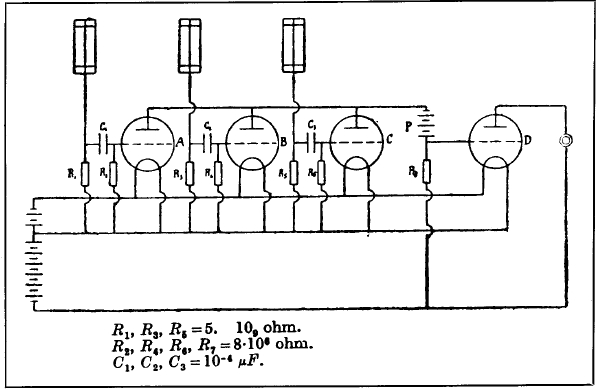Nel 1929 Bruno Rossi, ricercatore presso l’istituto di fisica sperimentale
dell’Università di Firenze [...] intuì quella che sarebbe stata la sua ragione di vita: indagare sulla natura di questi corpuscoli ionizzanti provenienti dall’alto. Doveva realizzare un circuito che permettesse di rivelare e contare le coincidenze che si verificavano in una certa unità di tempo e realizzò uno strumento molto semplice, il circuito a coincidenze.
L’involucro dei tubi Geiger è collegato al polo negativo di una batteria da 1200 volt (non
disegnata). La scarica nei tubi genera un impulso di tensione negativa sulle resistenze da
circa 5 gigaohm (5000 megaohm) tra il filo del Geiger e massa. Tale impulso viene accoppiato capacitivamente (10000 pF) alle griglie dei primi tre tubi, collegate a massa tramite resistenze di 8 megaohm. Questi tubi normalmente sono in conduzione e mantengono la griglia del quarto tubo a potenziale negativo tramite una batteria di 30 volt. Quando si verifica una coincidenza i primi tre tubi vengono interdetti, la griglia del quarto tubo, grazie alla resistenza di 8 megaohm tra griglia e positivo, assume potenziale positivo e nella cuffia connessa all’anodo si ascolta un “tic”. [...] Le resistenze di elevato valore non esistevano, venivano costruite riempiendo dei tubicini di vetro con una miscela di liquidi organici.

English translation:
"In 1928 Bruno Rossi, researcher at the experimental physics institute of Florence University, [...]understood what would be his goal in life: investigating the nature of these ionizing corpuscles raining from the above. He had to build a circuit which allowed the detection and counting of the coincidences that occurred within a given time interval, and he constructed a very simple instrument, the coincidence circuit.
The Geiger tubes are connected to the negative pole of a 1200 volt battery (not shown). The discharge in the tubes generates a negative voltage pulse on the 5-gigaohm resistences between the Geiger and ground. Such impulse is connected by capacitive coupling (10000 pF) to the grids of the first three tubes, connected to ground by 8 MOhm resistances. Such tubes normally conduct, and they maintain the grid of the fourth tube to negative potential by a 30 volt battery. When a coincidence is created, the first three tubes are inhibited, the grid of the fourth tube, thanks to the 8-MOhm resistance between grid and positive, acquires positive potential, and in the earphone connected to the anode one hears a "tic". [...] Resistances of such large value did not exist, and they were built by filling glass tubes with a organic liquid mix."
One may well wonder what organic liquid was used in the tubes...


